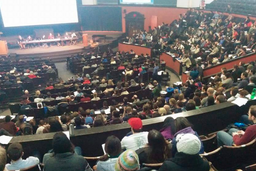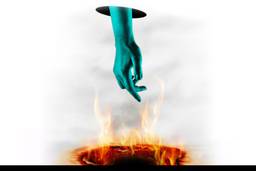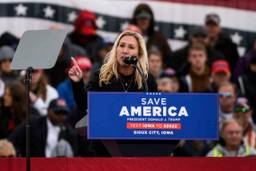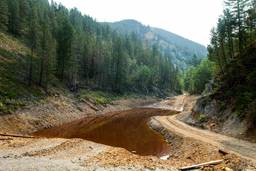Why Canada’s Most Progressive Major Party Didn’t Make Big Gains at the Polls
While the New Democratic Party campaigned on a more progressive platform, the Liberals campaigned to the left just enough to sow doubt about the NDP—while the NDP moved to the center.
Gerard Di Trolio
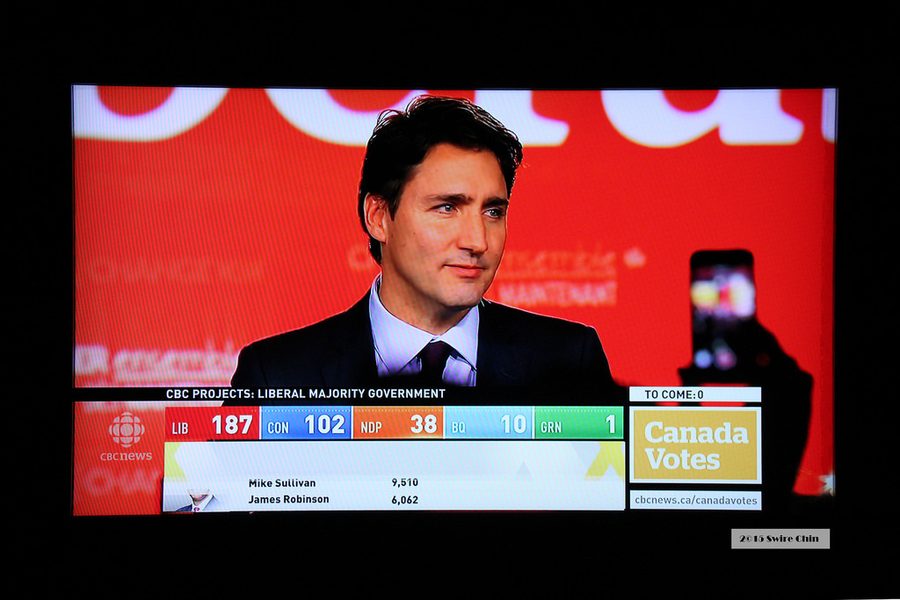
Canada’s longest and most unpredictable federal election campaign of modern times has finally come to an end.
After 78 days, the centrist Liberal Party, which started the contest third in the polls, finished with a strong majority government, increasing their seat total to 184 out of 338. The social democratic New Democratic Party (NDP), which began the campaign at the top of the polls, plunged into their traditional position of third place, losing over half of their seats. The ruling Conservatives lost 60 seats and will be the official opposition for the first time in almost a decade.
Though the final results were upsetting for many progressives and leftists who don’t trust the Liberals, especially as a majority government, given its history of implementing austerity, the fact remains: the arch-reactionary Stephen Harper is gone.
Recent days have seen many analyses of how things turned out the way they did. Most people seem to agree on the strength of the Liberal campaign. Liberal leader Justin Trudeau, son of former Prime Minister Pierre Trudeau, became a more confident campaigner as the election progressed. He was portrayed by both parties, especially the Conservatives, as gaffe-prone and inexperienced. But the charismatic Trudeau managed to capture the desire for change that many Canadians desired, according to polls taken throughout the campaign showed.
Harper’s reactionary agenda both at home and abroad gained him international notoriety and finally caught up to him. He and former Australian Prime Minister Tony Abbott were often singled out for their generally do-nothing approach to climate change, as both leaders relied on the energy and resource sectors to maintain high commodity prices to keep their economies growing.
With a recent collapse in resource prices, Harper’s economic policy had been exposed as unsustainable. Canada slipped into a “technical recession” in 2015, and reports showed that Harper’s record of job creation was the worse of any Canadian Prime Minister since World War II. While Harper was quick to blame international economic factors and claim Canada weathered the Great Recession better than many other advanced economies, stagnant wages, high household debt and precarious work slowly but surely took their toll on Canadian workers. While Harper was Prime Minister for nearly a decade, these contradictions were bound to lead to his undoing eventually.
As for the NDP, its supporters are crushed. Over a million voters from 2011 abandoned the party in this past election. And while winning 44 seats is technically their second-best result ever, the gains are little consolation given the gains the NDP expected to make, including winning power for the first time at the federal level.
There will surely be much soul searching within the party in coming weeks and months as to why things turned out the way they did. Some will blame the loss of over half of their seats in Quebec over the party’s stance on Muslim women wearing niqab during oath of citizenship ceremonies, which was used by both the Conservatives and the Bloc Québécois (BQ) as a wedge issue. While the BQ, a party dedicated to Quebec sovereignty, managed to take a rump caucus from two to 10 seats in the election probably because of this issue, the Liberal Party, like the NDP, took a principled stand against this racist strategy. The Liberals won 40 seats in Quebec, which is the first time since 1980 it has won over half of Quebec’s seats in the House of Commons. But this narrative does not explain the NDP’s collapse.
What better explains the NDP’s rout is its shifting strategy, especially over the past year.
NDP leader Tom Mulcair, a former Liberal Minister of the Environment in Quebec’s government, was selected as NDP leader in 2012. His commitment to social democratic politics was often suspect in the eyes of long-time New Democrats, but he was a strong debater and was seen as being “serious” enough to win government. But the NDP, seeing the Liberals in disarray, decided that marching further to the center could lead to victory.
Once Trudeau became Liberal leader in 2013, the NDP found themselves once again third in the polls. In late 2014 and early 2015, the NDP shifted back to the left with success. They proposed a $15 per hour minimum wage in federally regulated industries, a national $15 per day childcare program and strongly opposed the Conservatives anti-terror laws contained in Bill C-5. (The Liberals also supported this bill and Trudeau took a hit over it). These traditional NDP positions motivated the party’s base and led to a steady climb in the polls until they were in first place at the campaign’s outset. But the party’s eventual drift rightward was its undoing: The NDP exhibited strong caution at a time when Canadians were clearly looking for bold change.
Mulcair initially signaled his support for the Trans-Pacific Partnership, despite the NDP’s traditional allies in organized labor being resolutely against it. He also called for more cops on the streets throughout the country. But what really seemed to hurt the NDP was its pledge to balance the budget in its first year in office. This seemed shocking to many in the center and on the Left who were apprehensive as Canada’s economy teetered on the edge of a recession. The Liberals took advantage of the opening and promised to run three consecutive deficits of $10 billion per year. Given that Canada’s federal debt-to-GDP ratio is the lowest among G7 countries, such a commitment was hardly ambitious, but demonstrated that the Liberals were concerned with the economic anxieties of average Canadians.
The Liberals also managed to communicate their tax policy better than the NDP. Mulcair said he would ask “Canada’s largest corporations to contribute a little bit more” by raising the federal corporate tax rate by 2 percent (since 2000, Liberal and Conservative governments have gradually reduced it from 28 to 15 percent) and closing loopholes on CEO stock options. These are progressive measures, to be sure. But Trudeau gave a much simpler line that better captured the Canadian mood: He explicitly said the Liberals would raise taxes on the one percent to cut them for the middle class.
During a debate, Mulcair criticized this plan by arguing that such an increase of top rates would drive professionals like doctors from high tax provinces like New Brunswick where Trudeau’s tax hikes and the provincial tax rate would create a top bracket of over 50 percent. Needless to say, no one seemed to share Mulcair’s concern. (Of course, there’s a devil in the details of the Liberals’ plan, as well: The middle-class tax cut would kick in at around $44,000, which is still above Canada’s median income of $27,600. Thus, most Canadian workers would not see a tax cut.)
So while, on the whole, the NDP platform was more progressive than the Liberals’, especially on childcare and a proposal to finally bring in universal coverage of prescription drugs, one of the biggest gaps in Canada’s universal health care system, the Liberals managed to campaign to the left just enough to sow doubt about the NDP’s move to the center.
It also didn’t help the NDP that footage surfaced from Mulcair’s time as a minister in Quebec praising Margaret Thatcher, and the NDP disqualified candidates from running for even the mildest criticism of Israel’s treatment of Palestinians. Trudeau managed to use his charisma to sell a few tepidly progressive policies and convince the electorate that he was the only person that could defeat Harper.
So after steady growth throughout most of the 21st Century, the NDP now finds itself as a crossroads. It looks as if it will have to move back to the left to remain relevant, yet it seems that Mulcair will be allowed to choose whether to stay on as leader.
Debates about the future of the NDP are currently underway among the party’s members, but the NDP and progressive movements can’t waste much time on introspection or assuming all is well now that Harper is gone.
The Liberal Party is still very much a party of Toronto’s Bay Street (Canada’s equivalent to Wall Street). When the Liberals last held power from 1993 to 2006, a massive neoliberal restructuring was undertaken. Taxes and spending were slashed, and while Canada’s debt-to-GDP ratio was nearing 100 per cent in the mid-1990s, the amount of spending restraint needed to deal with this debt was overblown by the media and policymakers — leading to high levels of austerity that prevented an earlier economic recovery from the recession of the early 1990s.
Trudeau’s commitment to fighting climate change has also been vague. He promises to work with the provinces to deal with the issue but hasn’t committed to hard targets for greenhouse gas reduction. He also supports the Keystone XL pipeline, and the Liberal campaign co-chair had to resign when his links as a lobbyist to energy companies became public knowledge.
Still, the Liberals’ moves in their early days have been so far positive. Canada is removing its fighter planes from bombing runs against Islamic State, and Trudeau has promised to call an inquiry into the issue of missing and murdered indigenous women, which has been one of the most pressing demands of First Nation activists — ”immediately.” The first weeks of a Liberal government will probably see them implement their most progressive policies like marijuana legalization. There will also be the initial honeymoon that many new governments face, and it’s likely that Canada will experience a kind of “Trudeaumania 2.0” that will paper over the capital-friendly policies of the Trudeau goverment for a time.
While many of Harper’s worst policies have been seemingly repudiated, it will take a lot more work to make sure the Liberals live up to their own promises and to break the neoliberal consensus of Canada’s governing parties.

I hope you found this article important. Before you leave, I want to ask you to consider supporting our work with a donation. In These Times needs readers like you to help sustain our mission. We don’t depend on—or want—corporate advertising or deep-pocketed billionaires to fund our journalism. We’re supported by you, the reader, so we can focus on covering the issues that matter most to the progressive movement without fear or compromise.
Our work isn’t hidden behind a paywall because of people like you who support our journalism. We want to keep it that way. If you value the work we do and the movements we cover, please consider donating to In These Times.

